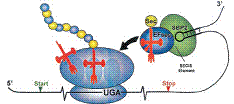Biochemistry, Department of

Vadim Gladyshev Publications
Document Type
Article
Date of this Version
April 2007
Abstract
Selenophosphate synthetase (SelD) generates the selenium donor for selenocysteine biosynthesis in eubacteria. One homologue of SelD in eukaryotes is SPS1 (selenophosphate synthetase 1) and a second one, SPS2, was identified as a selenoprotein in mammals. Earlier in vitro studies showed SPS2, but not SPS1, synthesized selenophosphate from selenide, whereas SPS1 may utilize a different substrate. The roles of these enzymes in selenoprotein synthesis in vivo remain unknown. To address their function in vivo, we knocked down SPS2 in NIH3T3 cells using small interfering RNA and found that selenoprotein biosynthesis was severely impaired, whereas knockdown of SPS1 had no effect. Transfection of SPS2 into SPS2 knockdown cells restored selenoprotein biosynthesis, but SPS1 did not, indicating that SPS1 cannot complement SPS2 function. These in vivo studies indicate that SPS2 is essential for generating the selenium donor for selenocysteine biosynthesis in mammals, whereas SPS1 probably has a more specialized, non-essential role in selenoprotein metabolism.


Comments
Published in Biochem. J. (2007) 404, 115–120 (Printed in Great Britain). ©The Authors Journal compilation ©2007 Biochemical Society. Permission to use. http://www.biochemj.org